|
USS SABLE (IX-81) |
 |
|
Displacement: 6,584
long tons (6,690 t) (as Sable) |
|
Length: 535 ft (163.1 m) (as Sable) |
|
Beam: 58 ft (17.7 m) (as Greater
Buffalo and Sable) |
|
Height: 21.3 ft (6.5 m) (as
Greater Buffalo) |
|
Decks: 7 (as Greater
Buffalo) |
|
Flight deck: 535'-5" ft x 58'-0"
(steel) |
|
Draft: 16'-0" |
Propulsion:
(6) single-end and (3)
double-end coal-fired Scotch boilers, 14' dia.;
Inclined 3-cylinder compound steam engine (abt. 165
psi);
66", 96", 96" bores x 108" stroke
(2) side paddlewheels,
abt. 100-tons ea. w/ 11 blades |
|
Power: 10,500 hp |
|
Speed: 18 kts (21 mph) |
|
Complement: 270 |
|
USS Sable (IX-81) was converted
to a training aircraft carrier used by
the United States Navy during World War II.
Originally built as the passenger ship
Greater Buffalo, a
side-wheel excursion steamer, she was
purchased by the Navy in 1942 and converted
to a training aircraft carrier to be used on
the Great Lakes. Lacking a hangar deck,
elevators or armament, she was not a true
warship, but provided advanced training of
naval aviators in carrier takeoffs and
landings.
On her first day of service fifty-nine
pilots became qualified within nine hours of
operations, with each making eight takeoffs
and landings. Pilot training was conducted
seven days a week in all types of weather
conditions. One aviator who trained upon the
Sable was future president George H. W.
Bush.
Following World War II, Sable was
decommissioned on 7 November 1945. She was
sold for scrapping on 7 July 1948 to the
H.H. Buncher Company. Sable and her sister
ship, USS Wolverine, hold the distinction of
being the only freshwater, coal-fired, side
paddle-wheel aircraft carriers used by the
United States Navy.
|
Refit
Sable was converted at the Erie Plant of American
Shipbuilding Company at Buffalo, New York. The cabins and
superstructure of the ship were removed leaving the main
deck. Along with additional supports, a steel flight deck
was installed instead of the originally planned Douglas-fir
wooden deck similar to what was installed on USS Wolverine.
The steel deck also allowed Sable to be used for the testing
a variety of non-skid coatings applied to the flight deck.
The deck of Sable was equipped with eight sets of arresting
cables as well. A bridge island or superstructure was
constructed on the starboard side of the ship along with
outriggers forward of the island for storing damaged
aircraft.
On the main deck a lecture room, along with
projection equipment, was constructed that could accommodate
more than forty aviators with bunks for twenty one aviators.
She was also equipped with a sick bay, operating room,
laundry, tailor shop, crew quarters, a cafeteria style
galley for the crew, a mess hall for the officers,
storerooms and a refrigerator.
Sable lacked a hangar deck,
elevators or armament, as her role was for the training of
pilots for carrier take-offs and landings. A number of crew
members assigned to Sable prior to her commissioning were
survivors of USS Lexington which had been lost earlier
during the Battle of the Coral Sea. Sable was commissioned
on 8 May 1943 with Captain Warren K. Berner in command.
|
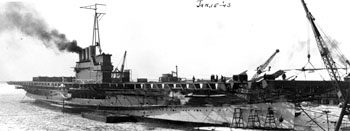 |
| Conversion to USS Sable (IX-81) showing four
exhaust funnels before encasing for two stack
arrangement. (US
Navy photo January 15, 1943.) |
| |
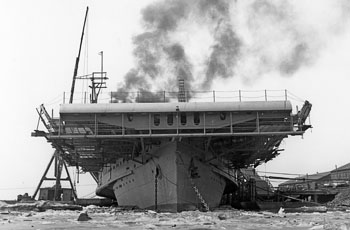 |
| Sable moored in Lake Erie ice during refitting
in early 1943 at American Shipbuilding Co. yard in
Buffalo, NY. The training carrier was
converted from the Great Lakes side-wheel excursion steamer
Greater Buffalo, launched in October 1924.
(Official U.S. Navy
photo, U.S. National Archives.) |
| |
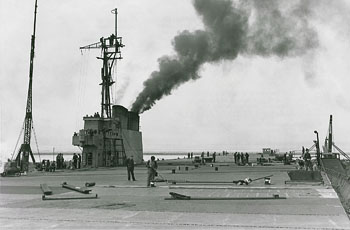 |
| Deck of USS Sable during refit, looking aft with
smoke rising from her coal-fired boilers. (Taken bet. Mar - Apr 1943) |
| |
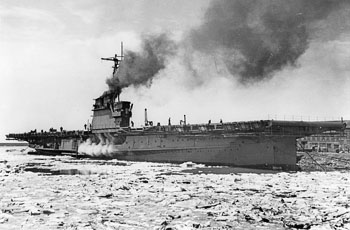 |
| Sable moored in Lake Erie ice at American
Shipbuilding Co. in Buffalo, NY.
(US Navy photo, ca. Apr 1943) |
| |
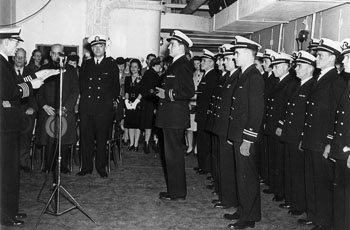 |
| Captain Warren K Berner (far left) reading his
orders to take command of the training carrier USS
Sable at her commissioning ceremony at the American
Shipbuilding Company in Buffalo, New York, 8 May
1943. |
|
|
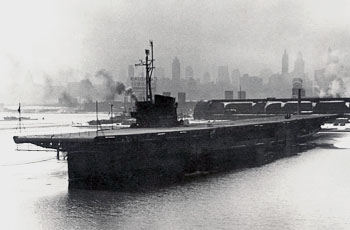 |
| USS Sable moored at Chicago's Navy Pier where it
and USS Wolverine were both home within vicinity of
NAS Glenview during WWII. |
| |
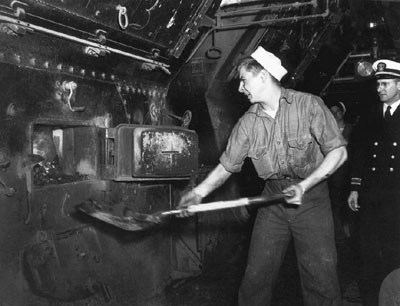 |
| One of 12 coal-fired Scotch marine boilers
onboard the USS Sable during Commissioning Day (8
May 1943). Original
equipment from days as passenger steamer Greater
Buffalo, built in 1924 by Detroit Shipbuilding
Company of Lorain, Ohio. The (6) single-ended boilers
are 14 ft dia. x 10 ft long and (3) double-ended boilers
are 14 ft dia. x 20 ft long. They produce about 165 psi.
(U.S. Naval Historical Center
photo) |
| |
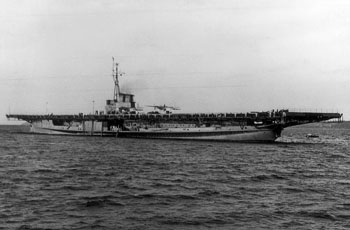 |
| USS Sable at anchor in West Grand Traverse Bay,
off Traverse City, Michigan, 10 Aug 1943. Note two
TDN-1 assault drone on the flight deck.
(US Navy photo # 80-G-387151) |
| |
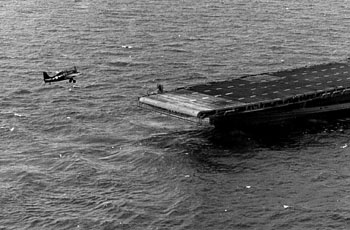 |
| An FM-2 Wildcat on final approach to land aboard
the training carrier USS Sable on Lake Michigan,
1943-44. |
| |
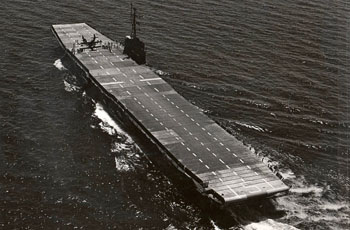 |
| An aircraft nosed over on the flight deck of
training aircraft carrier USS Sable on Lake
Michigan, 1944. |
| |
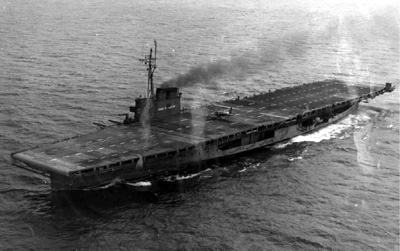 |
| Overhead view
of the WWII training aircraft carrier USS Sable (IX-81) underway on Lake Michigan.
An FM Wildcat is making
a deck launch in 1944-45. (US Navy
photo) |
| |
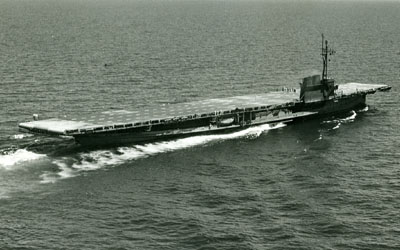 |
| USS Sable IX-81 underway with side paddlewheel
churning away on Lake Michigan, 1945. |
| |
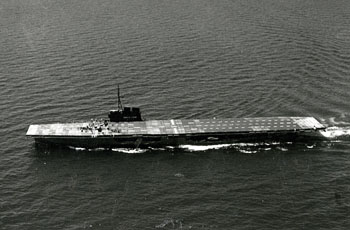 |
| Port side view of USS Sable from above with
aircraft nosed over on the flight deck, 1945. |
| |
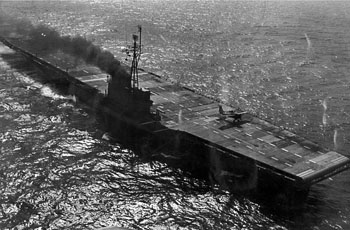 |
|
Starboard view of USS Sable underway with a Wildcat
fighter launching from the flight deck, 1945. |
|
|
|
|
|
|
Naval Service |
Training duty
|
|
The completed Sable departed Buffalo on 22 May 1943 and
arrived at her assigned homeport of Chicago, Illinois on 26
May 1943 and was docked at what came to be called Navy Pier
joining her sister ship USS Wolverine in what was casually
referred to as the "Corn Belt Fleet". Sable along with her
sister ship, Wolverine, were assigned to the 9th Naval
District Carrier Qualification Training Unit (CQTU) and were
tasked with qualifying pilots for carrier operations. With
the flight deck shorter and lower to the water it was felt
that if a pilot could master take offs and landings they
would have less trouble when they were stationed on a
standard size carrier. Pilot training was conducted seven
days a week with the fifty-nine pilots becoming qualified
within nine hours of her first day of service. One issue
that arose was that because of the lower top speed and
height of Sable there wasn't enough "wind over deck" needed
in order to launch certain types of aircraft or even carry
out training on calm days. In August 1943 Sable was used as
a base for testing the experimental TDN-1 torpedo drone
aircraft.
Naval aviators who had earned their wings at Pensacola or
Corpus Christi reported to NAS Glenview and received
orientation training before commencing the required minimum
of eight landings and takeoffs from the carriers. Before any
shipboard landings were attempted, however, practice
landings took place on runways that had been marked like
carrier decks.
Training on board the USS Sable was rigorous. The
training began at sunrise and didn’t end until sunset. Take
offs and landing were practiced throughout the 14 hour day
and would only be cancelled in foggy weather where the
takeoffs and landings would be too risky. Once the pilots
completed their daily takeoffs and landings, they would
return to Glenview. Rarely would a plane remain overnight on
the flight deck. It was the goal of the Navy to train each
pilot in the same type of aircraft that they would be flying
with the fleet. Shortages resulted and often prevented this
practice. Carrier fighter group pilots could qualify in
Grumman F4F Wildcats, while scout and bomber pilots flew in
the North American SNJ Texan. The program was so rigorous
that 30 pilots could be qualified in one day. On May 28th,
1944 the Sable broke her own record and qualified 59 pilots
with 498 landings in a total of 531 minutes.
Training on board the USS Sable was not limited to
pilots. On board experience was also given to carrier
personnel before they were assigned to escort carriers.
Every two weeks, a new class of 15 men reported to receive
four weeks of training in flight deck procedures.
Instructors and techs came to receive practical shipboard
training, along with thousands of other aircrew members.
|
|
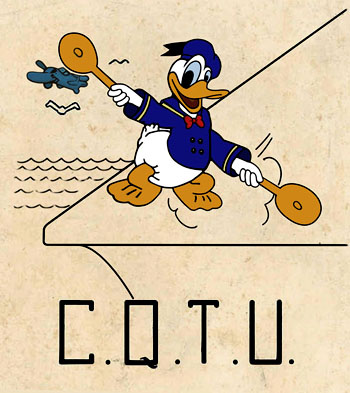 |
| 9th Naval District Carrier Qualification Training Unit
was at NAS Glenview, IL |
| |
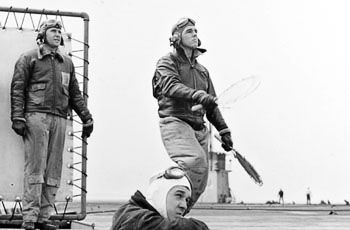 |
| Landing Signal Officer on USS Sable 1944 |
| |
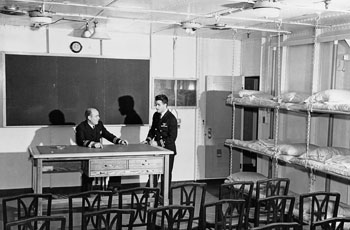 |
| Aviator's lecture room on USS Sable 1943 |
|
Decommissioning and disposal
|
|
|
|
Following the end of World War II, Sable was
decommissioned on 7 November 1945 and struck from the Naval
Vessel Register on 28 November 1945. Before she was to be
auctioned off a proposal was made by the Great Lakes
Historical society to have Sable become a museum for Great
Lakes history at Put-in-Bay, Ohio near the Commodore Perry
monument. When that proposal failed she was sold by the
Maritime Commission to H. H. Buncher Company on 7 July 1948
and was reported as "disposed of" on 27 July 1948. In order
to fit through the Welland Canal, Sable was cut down prior
to her journey to the ship breaking yard at Hamilton,
Ontario. It was reported that 28 feet (8.5 m) of her beam
along with 50 feet (15 m) of her stern flight deck were
removed prior to her being moved by tugboats. Even with the
modifications Sable only had 5 feet (1.5 m) of clearance on
each side while passing through the canal locks.
Legacy
Together,
Sable and Wolverine trained 17,820 pilots in 116,000 carrier
landings. Of these, 51,000 landings were on Sable alone. One
of the pilots qualified on Sable was a 20-year-old
Lieutenant, junior grade, future president George H. W.
Bush on Aug. 24, 1943. Of the estimated 135–300 aircraft lost during
training, 35 have been salvaged and the search for more is
underway. Both USS Sable and USS Wolverine hold the
distinction of being the only freshwater, coal-driven, side
paddle-wheel aircraft carriers used by the United States
Navy. USS Sable earned both the American Campaign Medal and
the World War II Victory Medal during her Naval career.
|
|
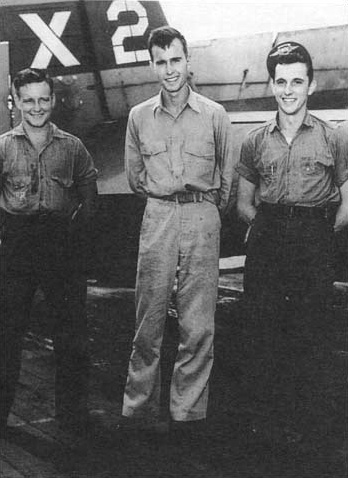 |
|
George H.W. Bush (middle) |
|
|
|
|
Flight deck operations on
USS Sable IX-81 from 1943-1945
|
 |
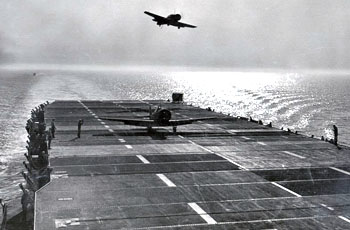 |
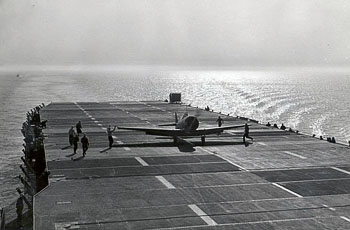 |
| Lecture Room for aviators on Sable 3-Jun-43 |
SNJ Texan just landed as other goes around |
SNJ Texan after landing 10-Jun-43 |
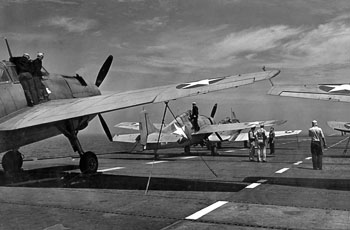 |
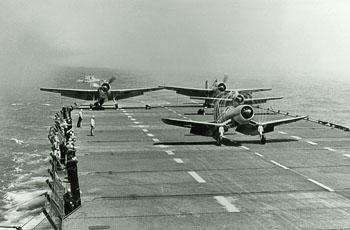 |
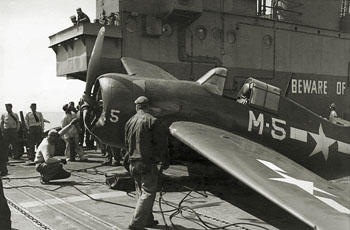 |
| TBF, FM-2, SNJ aircraft on deck |
F4U Corsair, Wildcat, TBFs, plane guard boat |
Mishap with FM-2 Wildcat (M-5) |
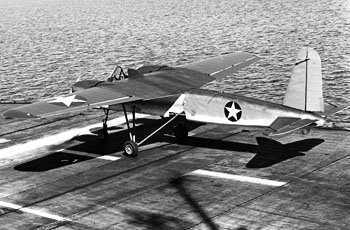 |
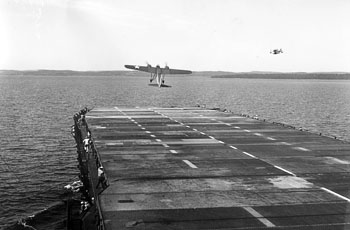 |
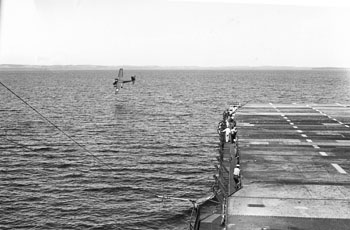 |
| TDN-1 drone tests 10-Aug-43 (#1 of 3) |
TDN-1 drone tests 10-Aug-43 (#2 of 3) |
TDN-1 drone tests 10-Aug-43 (#3 of 3) |
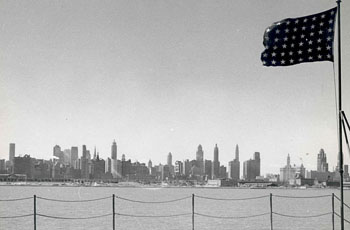 |
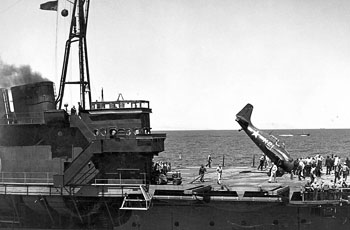 |
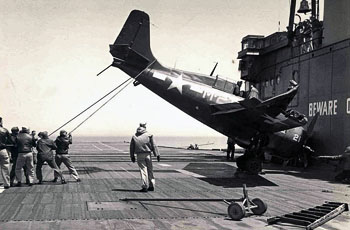 |
| Flag of USS Sable and Chicago skyline c 1944 |
Sable's bridge, FM-2 Wildcat (M-21) nose down |
FM-2 Wildcat (M-21) nose down & pilot |
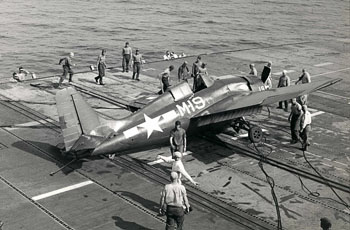 |
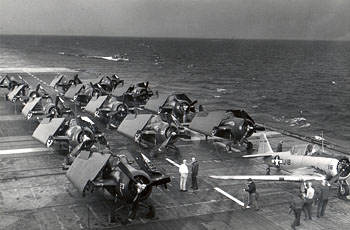 |
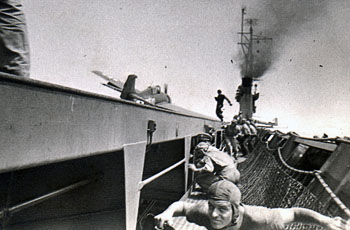 |
| FM-2 Wildcat hard landing buckles landing gear |
13 Wildcats & SNJ-4 tied down on Sable, 1944 |
Crewmen duck in catwalk during a wild landing |
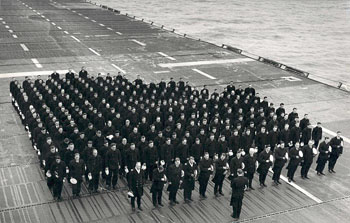 |
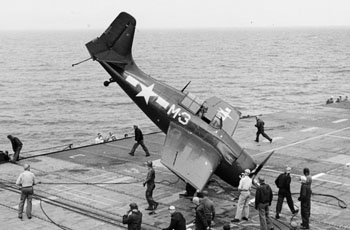 |
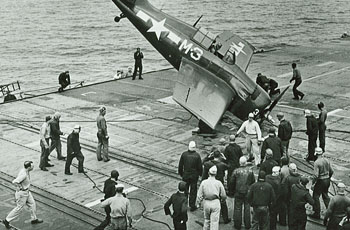 |
| Memorial service for Pres. Roosevelt 15-Apr-45 |
FM-2 Wildcat (M-3) barrier crash, #1 of 2 |
FM-2 Wildcat (M-3) barrier crash, #2 of 2 |
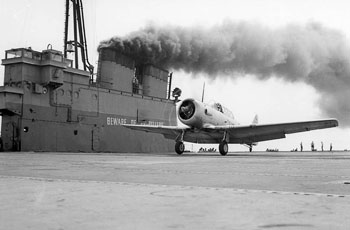 |
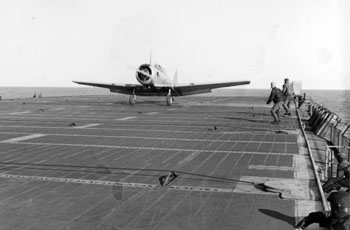 |
 |
| SNJ (J-10) launches, May-45 |
The 50,000th landing on USS Sable, May-45 |
Lt. Whitaker, Landing Signal Officer, May-45 |
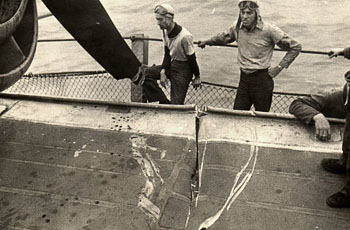 |
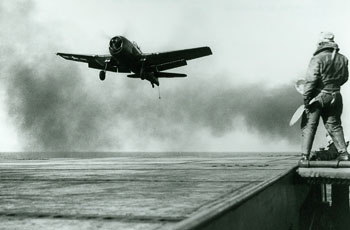 |
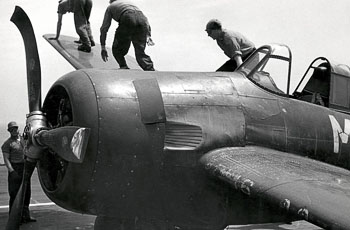 |
| Slice in steel deck by spinning propeller of an
F6F |
F6F-5 Hellcat attempts trap 1945 |
Crews move to secure FM-2 after hard landing |
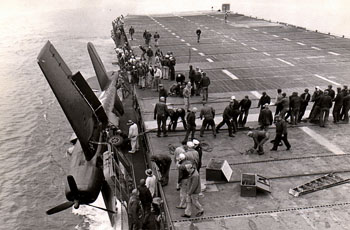 |
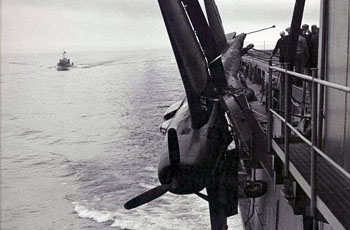 |
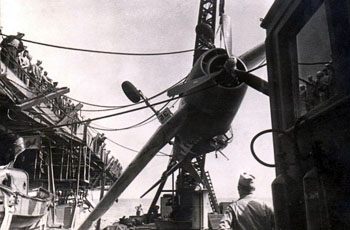 |
| Crews securing F6F Hellcat hanging over side |
Crews securing F6F Hellcat hanging over side |
Crews hoisting damaged Hellcat over to barge |
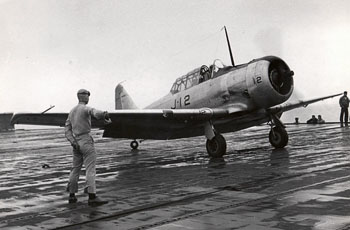 |
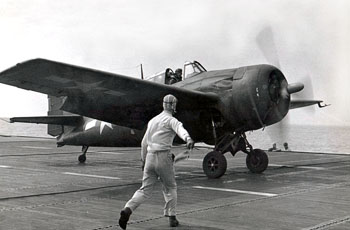 |
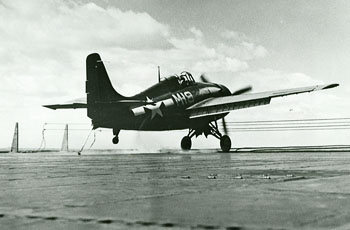 |
| SNJ Texan prepares to launch |
FM-2 Wildcat launch on USS Sable |
FM-2 Wildcat recovery on Sable |
|
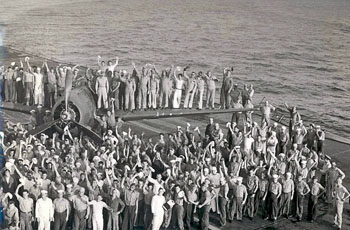 |
| V.J. Day on USS Sable
with crew and
aviators 14 Aug 1945 |
|
|
|
|
|
| |
|
History of Vessel |
 |
|
Name: S.S. Greater Buffalo |
|
Nickname: "Majestic of the
Great Lakes" |
|
Owner: Detroit and
Cleveland Navigation Co. (D&C) |
|
Route: Buffalo to Detroit |
|
Builder: American Ship Building Company,
Lorain, Ohio |
|
Cost: $3.5 million |
|
Hull
no.:
00786 |
|
Keel: 2 May 1923 |
|
Tonnage: 7,739 GRT as
Greater Buffalo |
|
Length: 518.7 ft (158.1 m) (as Greater
Buffalo) |
|
Beam: 58 ft (17.7 m) |
|
Height: 21.3 ft (6.5 m) (as
Greater Buffalo) |
|
Decks: 7 (as Greater
Buffalo) |
Installed power: Inclined
compound steam engine
| Piston #1: 66 in (170 cm) bore |
| Piston #2: 96 in (240 cm) bore |
| Piston #3: 96 in (240 cm) bore |
| Stroke: 108 in (270 cm) length |
| 9 × coal-fired Scotch boilers
(6) single-end, (3) double-end |
| 3 × 100 kW turbo generators for
ship lighting and operation. |
|
Propulsion: Two side-wheel
32.75 ft (10.0 m) diameter
11 floats
(paddles) 14.833 ft long and 5 ft wide, 30
rpm. |
|
Speed: 18 knots (33 km/h) |
|
Crew: 300 (as Greater
Buffalo) |
|
Notes: 2 × 6,000 lb (2,700
kg) anchors fore and 1 × 6,000 lb (2,700 kg)
anchor aft (as Greater Buffalo) |
|
Launched: 27 Oct 1924 |
|
Maiden voyage: 13 May 1925 |
|
Identification: U.S.
Official Number 223663, Code Letters
WSBH (1934–42) |
|
|
Acquired by U.S. Navy: 7 August 1942 |
|
Conversion: American Shipbuilding
Co., Buffalo, N.Y. |
|
Renamed: U.S.S. Sable (IX-81) on 19 Sep 1942 |
|
Commissioned: 8 May 1943 |
|
Decommissioned: 7 November 1945 |
|
Stricken: 28 November 1945 |
|
Fate:
Sold 7 July 1948 for scrapping |
| |
Construction
Greater Buffalo was
built in 1924 by the American Ship Building
Company of Lorain, Ohio as a side-wheel
excursion steamer designed by marine
architect Frank E. Kirby. Her hull number
was 00786 and the official number assigned
to her was 223663.
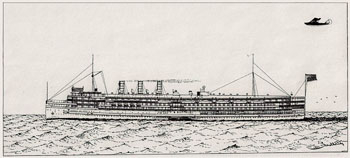 |
|
Drawing of steamer Greater Buffalo
designed by Frank E. Kirby (1922) |
The interior of the ship was designed by
W & J Sloane & Company of New York City in
what was referred to as "an adaptation of
the Renaissance style". There were 650
staterooms and more than 1,500 berths for
passengers. Each room had a telephone
connected by a central switch board located
in the ship's lobby. The highest priced
staterooms offered a private bathroom, couch
and balcony. Her dining room could seat 375.
Greater Buffalo could transport up to 103
vehicles on her main deck and 1,000 tons of
freight. At the time she was given the
nickname "Majestic of the Great Lakes".
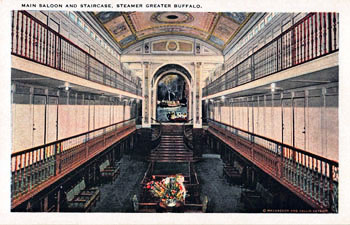 |
|
Postcard of Main Saloon and staircase aboard
steamer Greater Buffalo. |
Her hull was all steel with eleven
watertight compartments and a double bottom
divided into sixteen watertight
compartments. Hydraulically controlled
watertight doors could be remotely operated
from the engine room. The ship was also
equipped with twelve 60-person capacity
lifeboats along with an assortment of life
rafts and floats.
When completed, Greater Buffalo was 518.7
ft (158.1 m) in length, a beam of 58 ft (18
m), height of 21.3 ft (6.5 m) and measured
7,739 gross register tons. She had nine
boilers installed and was powered by a
three-cylinder inclined compound steam
engine. The engine, built by American
Shipbuilding, had one cylinder of 66 inches
(170 cm) diameter and two of 96 inches (240
cm) diameter by 108 inches (270 cm) stroke.
It was rated at 1,915 NHP.
She was seven decks high, carried three
funnels along her top and was equipped with
rudders at both ends of the ship for
improved maneuverability. She carried a crew
of 300 officers and enlisted with their
cabins stationed on the lowest deck fore and
aft of the ship's machinery. The final cost
for construction was $3,500,000.
|
History
The Detroit and Cleveland Navigation Company
ordered a pair of new excursion steamer ships for their
Great Lakes routes.
Greater Buffalo was among the largest
side wheel paddle ships on the Great Lakes
when she entered service in 1924. Her port
of registry was Detroit, Michigan.
On her maiden voyage to Buffalo, New York
on 13 May 1925 Greater Buffalo carried a
capacity number of passengers. The steamer
was used as a palatial overnight service
boat transporting up to 1,500 passengers
from Buffalo to Detroit, Michigan for the
Detroit and Cleveland Navigation Company.
Guests were entertained by an orchestra for
dancing in the main dining room following
dinner service as well as radio programming
provided in the main salon. Along with
passenger service Greater Buffalo offered
their customers the option of transportation
for 125 automobiles on their voyage.
During the Great Depression Greater
Buffalo was taken out of service from 1930
through 1935. In 1936 Greater Buffalo was
docked at Cleveland and used as a "floating
hotel" for attendees of the Republican
Convention.
Following the attack on Pearl Harbor in
1941 there was a need for large vessels that
could be converted into training aircraft
carriers for pilot training. Greater
Buffalo's length, following conversion,
would be roughly two thirds the length of an
Independence-class aircraft carrier and it
was felt by the navy that if pilots could
master takeoffs and landings on the shorter
deck they would have less problems
transitioning to a standard length carrier.
Other benefits by using her for training
were that an active duty combat ship would
not have to be used for training and with
her location on the Great Lakes she would be
out of the reach of enemy submarines and
mines. Greater Buffalo was acquired by the
Navy on 7 August 1942 by the War Shipping
Administration to be converted into a
training aircraft carrier and renamed Sable
on 19 September 1942.
|
|
|
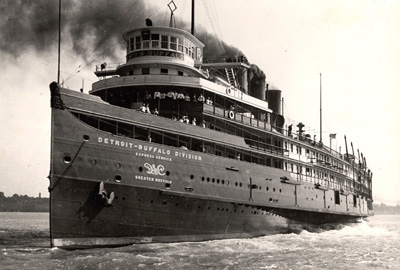 |
|
The SS Greater Buffalo was an inland excursion steamer
run on the Great Lakes, shown here
before her conversion to USS Sable (IX-81). |
| |
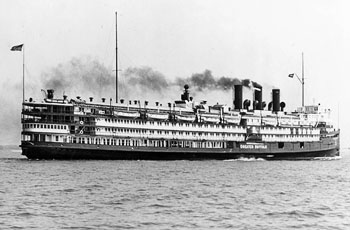 |
| SS Greater Buffalo arrives in Buffalo, NY, on Aug
6, 1942, to be converted into training aircraft carrier USS Sable (IX-81),
by the American Shipbuilding Company. |
| |
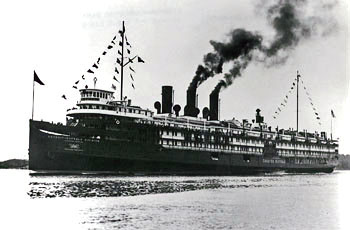 |
| Greater Buffalo before conversion to training
carrier |
| |
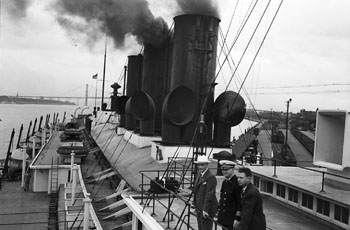 |
| Hurricane deck on Greater Buffalo viewed from
exterior of pilot house. |
| |
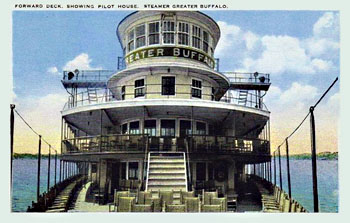 |
| Postcard showing the ship's pilot house as viewed
from forward deck. |
|
|
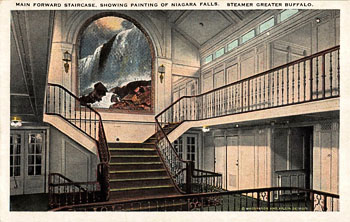 |
|
Main forward staircase, showing painting of Niagara
Falls and ship's once gleaming white interior. The
grand side-wheel excursion steamer would be gutted
and luxurious fittings torn out during conversion to
training carrier USS Sable IX-81 in 1942-43. |
| |
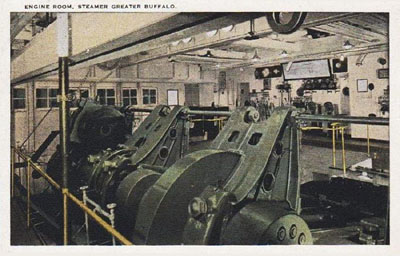 |
| Postcard of Greater Buffalo's engine room, which
remained mostly unchanged when refitted to US Sable
over winter of 1942-43. The engine is an inclined 3-cylinder
compound steam engine, having one 5.5 ft dia. high
pressure cylinder and two 8.0 ft
dia. cylinders with a 9.0 ft stroke. It is said to produce as
much as 12,000 ihp at 31 rpms. Shown is the
enormous crankshaft that turns the ship's two enormous
32'-9" diameter side
paddlewheels. |
| |
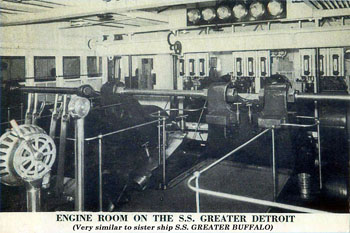 |
| Engine room looking forward at main bearings and
crankshaft, which is coupled to two 32 ft tall paddle wheels.
The port side wheel is located behind window sashes
to left. (Photo above) |
| |
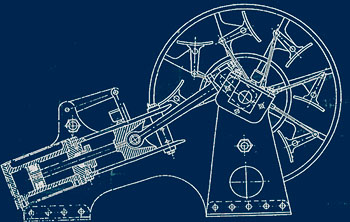 |
|
Layout of inclined engine used to drive side paddle
wheel steamer. |
|
|
|
|
| |